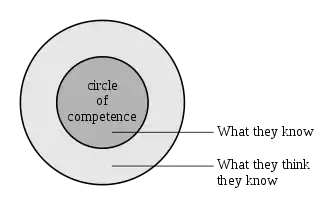Circle of competence
A circle of competence is the subject area which matches a person's skills or expertise.[1][2] The concept was developed by Warren Buffett and Charlie Munger as what they call a mental model, a codified form of business acumen, concerning the investment strategy of limiting one's financial investments in areas where an individual may have limited understanding or experience, while concentrating in areas where one has the greatest familiarity.[1][3] The strategy emphasizes the importance of aligning one's subjective assessment with actual competence.[1] Buffett summarized the concept in the motto, "Know your circle of competence, and stick within it. The size of that circle is not very important; knowing its boundaries, however, is vital."[4]

In his 1996 letter to Berkshire Hathaway, Buffett further expanded:
What an investor needs is the ability to correctly evaluate selected businesses. Note that word 'selected': You don't have to be an expert on every company, or even many. You only have to be able to evaluate companies within your circle of competence.
Sampan Nettayanun from Naresuan University traces the concept, if not the terminology, as far back as Andrew Carnegie, in his decision to concentrate on iron and steel, writing "My advice to young men would be not only to concentrate their whole time and attention on the one business in life in which they engage, but to put every dollar of their capital into it."[5]: 3
Operating within one's circle of competence may be compared with those who act over-confidently. For example, institutional investors who have been successful in the past are more likely to attribute their success to their own abilities, rather than external forces, and are therefore more likely to make investments in areas outside their circle of competence.[6] The strategy of operating within their individual circles has been cited as the reason both Buffett and Munger avoided investing in the technology sector.[7]
The breadth of any individual's circle of competence may be determined by a range of factors, including their profession, spending habits, and the types of products they normally use. Remaining within one's circle confers a number of benefits, such as an unfair information advantage, the narrowing of available options, and the reduction of poor decision making.[8][9]
See also
- Competence (human resources) – Ability of a person to do a job properly
- Dunning–Kruger effect – Cognitive bias about one's own skill
- Peter principle – Management concept by Laurence J. Peter
References
- "The 'Circle Of Competence' Theory Will Help You Make Vastly Smarter Decisions". Business Insider. Retrieved 13 January 2018.
- Robinson, Bernard E. (May 12, 2016). The Skills of an Effective Leader: Becoming a Leader Others Want to Follow. Xlibris Corporation. ISBN 9781514483541. Retrieved 13 January 2018.
- "Mental Models: The Best Way to Make Intelligent Decisions (113 Models Explained)". Farnam Street. Retrieved 13 January 2018.
- Dobelli, Rolf (Nov 7, 2017). The Art of the Good Life: 52 Surprising Shortcuts to Happiness, Wealth, and Success. Hachette Books. ISBN 9780316445092. Retrieved 13 January 2018.
- Nettayanun, Sampan (October 2016). "Value investing: Circle of competence in the Thai insurance industry". Puey Ungphakorn Institute for Economic Research. 46.
- Nguyen, Tristan; Schüßler, Alexander (2012). "Investment decisions and socio-demographic characteristics – Empirical evidence from Germany". International Journal of Economics and Finance. 4 (9): 2. doi:10.5539/ijef.v4n9p1. Retrieved 13 January 2018.
- "Charlie Munger: The power of not making stupid decisions". HITC. CNBC. Retrieved 13 January 2018.
- Ang, Rusmin (September 2, 2016). "3 reasons why you should stay within your circle of competence". The Fifth Person. Retrieved 13 January 2018.
- Ang, Rusmin; Chng, Victor (Apr 23, 2013). Value Investing in Growth Companies: How to Spot High Growth Businesses and Generate 40% to 400% Investment Returns. John Wiley & Sons. ISBN 9781118567791. Retrieved 13 January 2018.